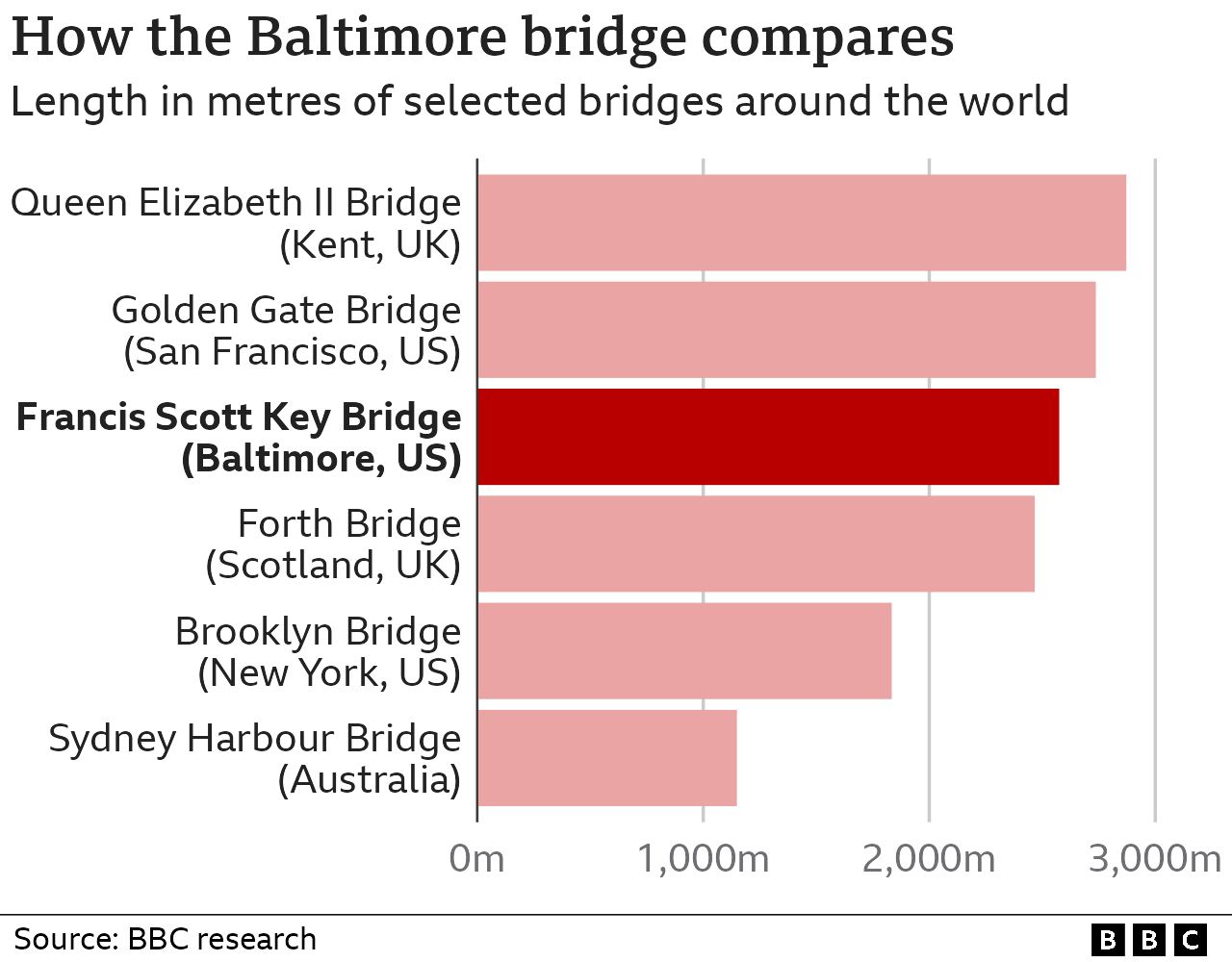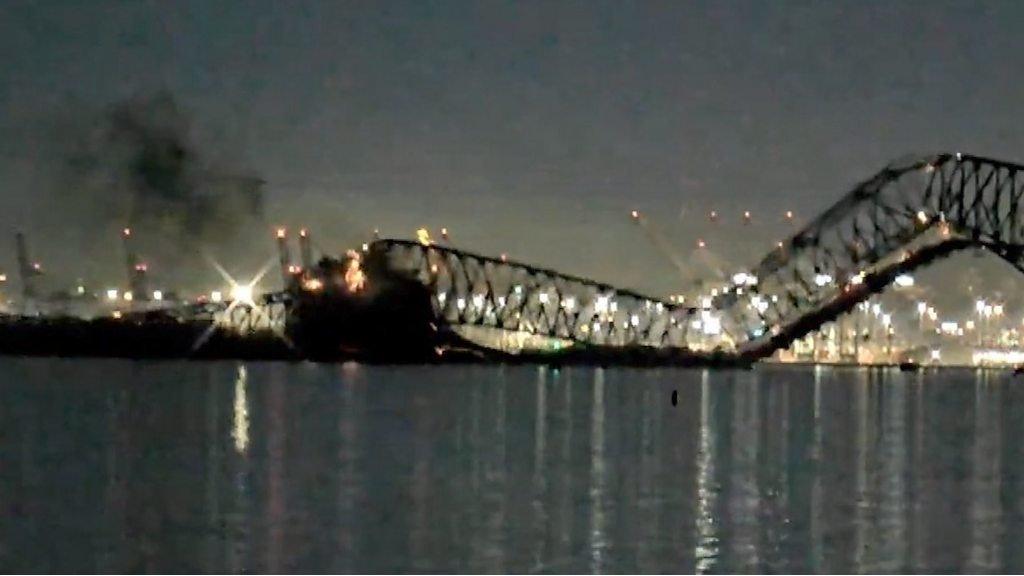Baltimore Francis Scott Key Bridge collapse: What we know about ship and bridge
- Published
Tracking data shows the path of the Dali container towards the bridge
A container ship has crashed into the landmark Francis Scott Key Bridge near the US city of Baltimore, causing most of it to collapse.
Several vehicles on the bridge at the time plunged into the waters of the River Patapsco. Hours later, the Coast Guard said at least six people were presumed dead.
The Port of Baltimore remains closed to ships and President Joe Biden vowed the federal government will cover "the entire cost" of rebuilding the bridge.
On Wednesday, investigators boarded the stricken ship and recovered its data recorder which they hope may explain the catastrophic power failure that caused it to go off course.
What do we know about the bridge?
The Baltimore bridge, known more simply as the Key Bridge, was opened in 1977 in honour of Francis Scott Key, a 19th Century Maryland poet who wrote the words for the US national anthem, the Star Spangled Banner.
The bridge was 1.6 miles (2.6km) long and spanned the Patapsco River and Baltimore harbour. The river flows out into Chesapeake Bay, the largest estuary in the US.

It is described as a continuous truss bridge, and its main span of 1,200ft was the third longest of any bridge of its type in the world.
Video footage from the incident appears to show the bridge collapsing instantaneously after the container ship Dali hits one of its pillars. This happened at around 01:30 local time (05:30 GMT) on Tuesday.

Eight people - all part of a construction crew contracted to fix potholes and make repairs - were seen on the bridge at the time.
Two of the workers are from Guatemala, according to the country's consulate in Maryland.
Two people were pulled from the water after the bridge collapsed, one in a serious condition and one apparently uninjured, officials said.
But six others likely perished due to cold water temperatures and hours spent under the surface, the US Coast Guard said on Tuesday evening. The agency said it was suspending its major search and rescue operation that lasted all day.
It will now focus on a recovery mission to locate bodies and bring closure to families of the victims.
Officials say first responders worked in treacherous conditions to try to find the men, as there were "some cargo or retainers hanging from the bridge" as well as dangerous debris in the water.
The water temperature in the harbour was said to be about 9C (48F). Hypothermia can occur when a person's body temperature drops below 35C.
Baltimore fire officials said vehicles had been detected in the water by sonar.
What do we know about the ship?
The Singapore-flagged container ship Dali was originally built for Greek shipowner Oceanbulk by South Korea's Hyundai Heavy Industries.
It is currently operated by the charter vessel company Synergy Group and had been temporarily leased by container shipping giant Maersk, a Maersk statement said.
Maersk added that it was carrying cargo for Maersk customers but that no company personnel were on board at the time.

The ship set off from Baltimore's Seagirt Marine Terminal at around 00:24 local time on Tuesday, en route for Colombo, Sri Lanka.
Its speed steadily increased and it maintained a straight route south east along the Patapsco River.

Then at 01:25 MarineTraffic data shows that the ship suddenly diverted from its straight course and began to slow down.
Around this time, video shows that all lights on the exterior of the ship suddenly went out and smoke began emanating from the ship's funnel.
Shortly afterwards it hit the bridge.
A mayday signal was sent when the ship was approaching the bridge, which gave authorities time to stop cars driving onto the bridge and "saved lives", Maryland Governor Wes Moore said.
He added that the vessel had been moving at a "very, very rapid" eight knots, or roughly 9mph (15km/h).
An unclassified memo from the US Cybersecurity and Infrastructure Agency obtained by the BBC's US partner CBS says the Dali had "lost propulsion".

Synergy said the crew, who are all Indian nationals, and the two pilots, both US citizens from Baltimore, had all been accounted for and there were no reports of any injuries.
The company said there were several possible explanations for the incident but that, with two pilots present, such a crash was unusual.
A shipping expert told the BBC that the crash could have been caused by engine failure, steering failure or generator blackout.
This is not the first incident involving the Dali.
While attempting to leave the Belgian port of Antwerp in 2016 the ship scraped its stern along the quay damaging the hull, external. There were no reports of injuries or spillages.
The Dali was flagged with Singapore in October 2016. the Maritime and Port Authority of Singapore (MPAS) says.
Certificates covering the structural integrity of the vessel and functionality of the vessel's equipment were valid at the time of the incident, according to the MPAS.
The vessel underwent and passed two separate foreign port state inspections in June and September 2023, the authority adds. In the June 2023 inspection, a faulty monitor gauge for fuel pressure was rectified before the vessel departed the port.
What will be the impact of the bridge's collapse?
The location of the Key Bridge suggests there will be major disruption to road traffic for months and even years to come. Shipping activity in the port of Baltimore will also be severely affected.
The four-lane bridge was part of Interstate 695, the outer ring road around Baltimore city known as the "Baltimore Beltway", and carried an estimated 11.5 million vehicles per year.

It will still be possible to cross Baltimore harbour by tunnel closer to the city, but local authorities have declared a "major traffic alert", anticipating significant traffic problems after the incident.
The bridge's collapse will, in particular, be a major problem for lorries carrying hazardous materials, which were able to cross the bridge but are banned from the alternative tunnel route.
But the incident has created no less of a problem for shipping.
Transportation Secretary Pete Buttigieg declined on Tuesday to provide a timeline for the port's closure but said there will be a "major and protracted impact to supply chains".
Container shipping expert Lars Jansen said what had happened was a "major disaster" which would "create significant problems on the US East Coast for US importers and exporters".

As dawn broke the ship was seen tangled up in the remains of the bridge
On top of some 21,000 units of cargo having to go through other ports in the region, he says "multiple merchant vessels are now trapped in the port of Baltimore". None are container ships but there are some bulk carriers.
It is estimated that around 800,000 vehicles passed through the port in 2023, moving a record 1.3 million tons of imported cargo.
However, Mr Jansen says that while there will be some delays and added costs, from a global perspective the incident will not have a significant impact.
Related topics
- Published26 March 2024
